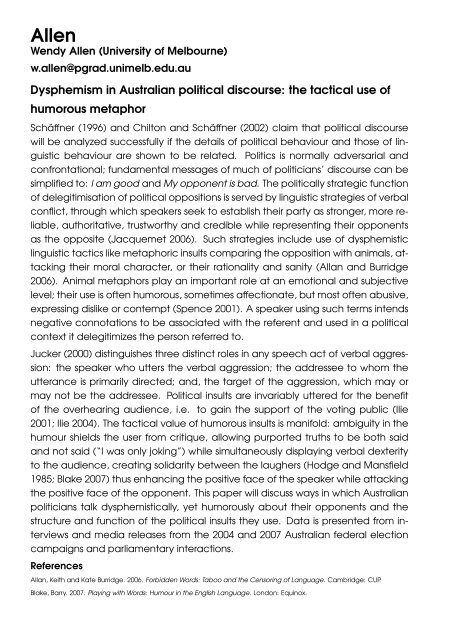ALS 2010 Annual Conference Programme - Australian Linguistic ...
ALS 2010 Annual Conference Programme - Australian Linguistic ...
ALS 2010 Annual Conference Programme - Australian Linguistic ...
You also want an ePaper? Increase the reach of your titles
YUMPU automatically turns print PDFs into web optimized ePapers that Google loves.
Allen<br />
Wendy Allen (University of Melbourne)<br />
w.allen@pgrad.unimelb.edu.au<br />
Dysphemism in <strong>Australian</strong> political discourse: the tactical use of<br />
humorous metaphor<br />
Schäffner (1996) and Chilton and Schäffner (2002) claim that political discourse<br />
will be analyzed successfully if the details of political behaviour and those of linguistic<br />
behaviour are shown to be related. Politics is normally adversarial and<br />
confrontational; fundamental messages of much of politicians’ discourse can be<br />
simplified to: I am good and My opponent is bad. The politically strategic function<br />
of delegitimisation of political oppositions is served by linguistic strategies of verbal<br />
conflict, through which speakers seek to establish their party as stronger, more reliable,<br />
authoritative, trustworthy and credible while representing their opponents<br />
as the opposite (Jacquemet 2006). Such strategies include use of dysphemistic<br />
linguistic tactics like metaphoric insults comparing the opposition with animals, attacking<br />
their moral character, or their rationality and sanity (Allan and Burridge<br />
2006). Animal metaphors play an important role at an emotional and subjective<br />
level; their use is often humorous, sometimes affectionate, but most often abusive,<br />
expressing dislike or contempt (Spence 2001). A speaker using such terms intends<br />
negative connotations to be associated with the referent and used in a political<br />
context it delegitimizes the person referred to.<br />
Jucker (2000) distinguishes three distinct roles in any speech act of verbal aggression:<br />
the speaker who utters the verbal aggression; the addressee to whom the<br />
utterance is primarily directed; and, the target of the aggression, which may or<br />
may not be the addressee. Political insults are invariably uttered for the benefit<br />
of the overhearing audience, i.e. to gain the support of the voting public (Ilie<br />
2001; Ilie 2004). The tactical value of humorous insults is manifold: ambiguity in the<br />
humour shields the user from critique, allowing purported truths to be both said<br />
and not said (“I was only joking”) while simultaneously displaying verbal dexterity<br />
to the audience, creating solidarity between the laughers (Hodge and Mansfield<br />
1985; Blake 2007) thus enhancing the positive face of the speaker while attacking<br />
the positive face of the opponent. This paper will discuss ways in which <strong>Australian</strong><br />
politicians talk dysphemistically, yet humorously about their opponents and the<br />
structure and function of the political insults they use. Data is presented from interviews<br />
and media releases from the 2004 and 2007 <strong>Australian</strong> federal election<br />
campaigns and parliamentary interactions.<br />
References<br />
Allan, Keith and Kate Burridge. 2006. Forbidden Words: Taboo and the Censoring of Language. Cambridge: CUP.<br />
Blake, Barry. 2007. Playing with Words: Humour in the English Language. London: Equinox.



